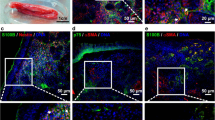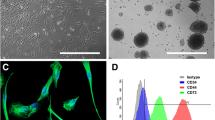Abstract
The aim of this study is to identify rat nasal septum respiratory mucosa-derived mesenchyme stem cells (RM-MSCs) and to compare its neural lineage differentiation capacity with bone marrow-derived mesenchyme stem cells (BM-MSCs) after a short period of neural induction culture in vitro. The cell morphology was observed with light microscopy; cell proliferation was assessed by 3-(4,5-dimethylthiazol-2-yl)-2,5-diphenyltetrazolium bromide (MTT). The characteristics of the cells were evaluated with flow cytometry, immunofluorescence, real-time quantitative PCR (RT-PCR), and Western blotting. The results showed that rat nasal respiratory mucosa contains RM-MSCs that exhibited similar proliferation rate as BM-MSCs in vitro. Both RT-PCR and Western blotting analyses demonstrated that RM-MSCs showed higher expression of neural lineage markers than BM-MSCs after a short period of neural induction culture, and secreted higher level of brain-derived neurotrophic factor. RM-MSCs were more amenable to differentiate into neural or glial cell after a short period of neural induction culture than BM-MSCs in vitro; and it could be considered as another optimal source of stem cells for cell-based therapy to neurological diseases.






Similar content being viewed by others
References
Agrawal A et al (2004) Olfactory ensheathing cell transplantation restores functional deficits in rat model of Parkinson’s disease: a cotransplantation approach with fetal ventral mesencephalic cells. Neurobiol Dis 16:516–526
Al-Nbaheen M et al (2013) Human stromal (mesenchymal) stem cells from bone marrow, adipose tissue and skin exhibit differences in molecular phenotype and differentiation potential. Stem Cell Rev 9:32–43
Anker PS et al (2004) Isolation of mesenchymal stem cells of fetal or maternal origin from human placenta. Stem Cells 22:1338–1345
Arthur A et al (2008) Adult human dental pulp stem cells differentiate toward functionally active neurons under appropriate environmental cues. Stem Cells 26:1787–1795
Barnabé GF et al (2009) Chemically-induced RAT mesenchymal stem cells adopt molecular properties of neuronal-like cells but do not have basic neuronal functional properties. PLoS ONE 4:e5222
Bianco JI et al (2004) Neurotrophin 3 promotes purification and proliferation of olfactory ensheathing cells from human nose. Glia 45:111–123
Bianco P et al (2008) Mesenchymal stem cells: revisiting history, concepts, and assays. Cell Stem Cell 2:313–319
Blondheim NR et al (2006) Human mesenchymal stem cells express neural genes, suggesting a neural predisposition. Stem Cells Dev 15:141–164
Boyd JG et al (2003) Glial cell line-derived neurotrophic factor and brain-derived neurotrophic factor sustain the axonal regeneration of chronically axotomized motoneurons in vivo. Exp Neurol 183:610–619
Brazelton TR et al (2000) From marrow to brain: expression of neuronal phenotypes in adult mice. Science 290:1775–1779
Centenaro LA et al (2011) Olfactory and respiratory lamina propria transplantation after spinal cord transection in rats: effects on functional recovery and axonal regeneration. Brain Res 1426:54–72
Chen Q et al (2005) Protective effects of bone marrow stromal cell transplantation in injured rodent brain: synthesis of neurotrophic factors. J Neurosci Res 80:611–619
Davidson RM (1994) Neural form of voltage-dependent sodium current in human cultured dental pulp cells. Arch Oral Biol 39:613–620
Delorme B et al (2009) The human nose harbors a niche of olfactory ectomesenchymal stem cells displaying neurogenic and osteogenic properties. Stem Cell Dev 19:853–866
Dennis JE et al (2002) Origin and differentiation of human and murine stroma. Stem Cells 20:205–214
Dominici M et al (2006) Minimal criteria for defining multipotent mesenchymal stromal cells. The international society for cellular therapy position statement. Cytotherapy 8:315–317
Dupin E et al (2003) Development of melanocyte precursors from the vertebrate neural crest. Oncogene 22:3016–3023
Dupin E et al (2007) Neural crest progenitors and stem cells. CR Biol 330:521–529
Ebert AD et al (2008) Human neural progenitor cells over-expressing IGF-1 protect dopamine neurons and restore function in a rat model of Parkinson’s disease. Exp Neurol 209:213–223
Feron F et al (1998) New techniques for biopsy and culture of human olfactory epithelial neurons. Arch Otolaryngol 124:861–866
Foudah D et al (2012) Expression of neural markers by undifferentiated rat mesenchymal stem cells. J Biomed Biotechnol 2012:820821
Friedenstein AJ et al (1974) Stromal cells responsible for transferring the microenvironment of the hemopoietic tissues: cloning in vitro and retransplantation in vivo. Transplantation 17:331–340
Girard SD et al (2011) Isolating nasal olfactory stem cells from rodents or humans. J Visual Exp 54:e2762
Gronthos S et al (2002) Stem cell properties of human dental pulp stem cells. J Dent Res 81:531–535
Han J et al (2003) Cranial neural crest-derived mesenchymal proliferation is regulated by msx1-mediated p19ink4d expression during odontogenesis. Dev Biol 261:183–196
Huang AH et al (2008) Putative dental pulp-derived stem/stromal cells promote proliferation and differentiation of endogenous neural cells in the hippocampus of mice. Stem Cells 26:2654–2663
Huang G-J et al (2009) Mesenchymal stem cells derived from dental tissues vs. those from other sources: their biology and role in regenerative medicine. J Dent Res 88:792–806
Ibarretxe G et al (2012) Neural crest stem cells from dental tissues: a new hope for dental and neural regeneration. Stem Cells Int 2012:103503
Janebodin K et al (2011) Isolation and characterization of neural crest-derived stem cells from dental pulp of neonatal mice. PLoS ONE 6:e27526
Jones LL et al (2001) Neurotrophic factors, cellular bridges and gene therapy for spinal cord injury. J Physiol 533:83–89
Kato T et al (2000) Transplantation of human olfactory ensheathing cells elicits remyelination of demyelinated rat spinal cord. Glia 30:209–218
Khoo ML et al (2011) Transplantation of neuronal-primed human bone marrow mesenchymal stem cells in hemiparkinsonian rodents. PLoS ONE 6:e19025
Labat ML et al (2000) On the track of a human circulating mesenchymal stem cell of neural crest origin. Biomed Pharmacother 54:146–162
Li Y et al (2002) Human marrow stromal cell therapy for stroke in rat neurotrophins and functional recovery. Neurology 59:514–523
Lindsay RM (1988) Nerve growth factors (NGF, BDNF) enhance axonal regeneration but are not required for survival of adult sensory neurons. J Neurosci 8:2394–2405
Lipsky RH et al (2007) Brain-derived neurotrophic factor in neuronal survival and behavior-related plasticity. Ann N Y Acad Sci 1122:130–143
Liu J et al (2013) Fibrin scaffolds containing ectomesenchymal stem cells enhance behavioral and histological improvement in a rat model of spinal cord injury. Cells Tissues Organs 198:35–46
Lu P et al (2003) Neural stem cells constitutively secrete neurotrophic factors and promote extensive host axonal growth after spinal cord injury. Exp Neurol 181:115–129
Mezey É et al (2000) Turning blood into brain: cells bearing neuronal antigens generated in vivo from bone marrow. Science 290:1779–1782
Ming G et al (2011) Adult neurogenesis in the mammalian brain: significant answers and significant questions. Neuron 70:687–702
Morikawa S et al (2009) Development of mesenchymal stem cells partially originate from the neural crest. Biochem Biophys Res Commun 379:1114–1119
Nash HH et al (2001) New method of purification for establishing primary cultures of ensheathing cells from the adult olfactory bulb. Glia 34:81–87
Paino F et al (2010) Ecto-mesenchymal stem cells from dental pulp are committed to differentiate into active melanocytes. Eur Cell Mater 20:295–305
Park KI et al (2006) Neural stem cells may be uniquely suited for combined gene therapy and cell replacement: evidence from engraftment of neurotrophin-3-expressing stem cells in hypoxic–ischemic brain injury. Exp Neurol 199:179–190
Pendleton C et al (2013) Mesenchymal stem cells derived from adipose tissue vs bone marrow. In vitro comparison of their tropism towards gliomas. PLoS ONE 8:e58198
Posel C et al (2012) Density gradient centrifugation compromises bone marrow mononuclear cell yield. PLoS ONE 7:e50293
Raedt R et al (2007) Differentiation assays of bone marrow-derived multipotent adult progenitor cell (MAPC)-like cells towards neural cells cannot depend on morphology and a limited set of neural markers. Exp Neurol 203:542–554
Romanov YA et al (2003) Searching for alternative sources of postnatal human mesenchymal stem cells: candidate MSC-like cells from umbilical cord. Stem Cells 21:105–110
Rubio D et al (2005) Spontaneous human adult stem cell transformation. Cancer Res 65:3035–3039
Sakai K et al (2012) Human dental pulp-derived stem cells promote locomotor recovery after complete transection of the rat spinal cord by multiple neuro-regenerative mechanisms. J Clin Investig 122:80–90
Schnabel J (2008) Neuroscience: standard model. Nature 454:682–685
Shumsky J et al (2003) Delayed transplantation of fibroblasts genetically modified to secrete BDNF and NT-3 into a spinal cord injury site is associated with limited recovery of function. Exp Neurol 184:114–130
Song S et al (2007) Comparison of neuron-like cells derived from bone marrow stem cells to those differentiated from adult brain neural stem cells. Stem Cell Dev 16:747–756
Suzuki H et al (2011) Transplantation of neurospheres derived from bone marrow stromal cells promotes neurological recovery in rats with spinal cord injury. Med Mol Morphol 44:131–138
Takashima Y et al (2007) Neuroepithelial cells supply an initial transient wave of MSC differentiation. Cell 129:1377–1388
Thomas MG et al (2011) Bone marrow stromal cells as replacement cells for Parkinson’s disease: generation of an anatomical but not functional neuronal phenotype. Transl Res 157:56–63
Tobias C et al (2003) Delayed grafting of BDNF and NT-3 producing fibroblasts into the injured spinal cord stimulates sprouting, partially rescues axotomized red nucleus neurons from loss and atrophy, and provides limited regeneration. Exp Neurol 184:97–113
Woodbury D et al (2000) Adult rat and human bone marrow stromal cells differentiate into neurons. J Neurosci Res 61:364–370
Wouters G et al (2007) Isolation of amniotic fluid-derived mesenchymal stem cells. J Prenatal Med 1:39–40
Acknowledgments
This study was supported by grants from Jiangsu Province Health Department (KF200956) and the Changzhou Science & Technology Bureau (CJ20122027), P. R. China. The authors acknowledge Dr. Jizong Gao, MD, PhD, for his critical editorial assistance. We are also gratitude to an anonymous reviewer for his/her professional comments and suggestions during the reviewing processes.
Conflict of interest
We state that the manuscript, or parts of it, have not been and will not be submitted elsewhere for publication. Xin Gao, Jinbo Liu, Jian Zhang, Jun Zhang, and Hongjun Zou have agreed to the submission of the final manuscript and declare no conflicts of interest.
Author information
Authors and Affiliations
Corresponding author
Rights and permissions
About this article
Cite this article
Gao, X., Zhang, J., Zhang, J. et al. Identification of Rat Respiratory Mucosa Stem Cells and Comparison of the Early Neural Differentiation Potential with the Bone Marrow Mesenchymal Stem Cells In Vitro. Cell Mol Neurobiol 34, 257–268 (2014). https://doi.org/10.1007/s10571-013-0009-6
Received:
Accepted:
Published:
Issue Date:
DOI: https://doi.org/10.1007/s10571-013-0009-6




